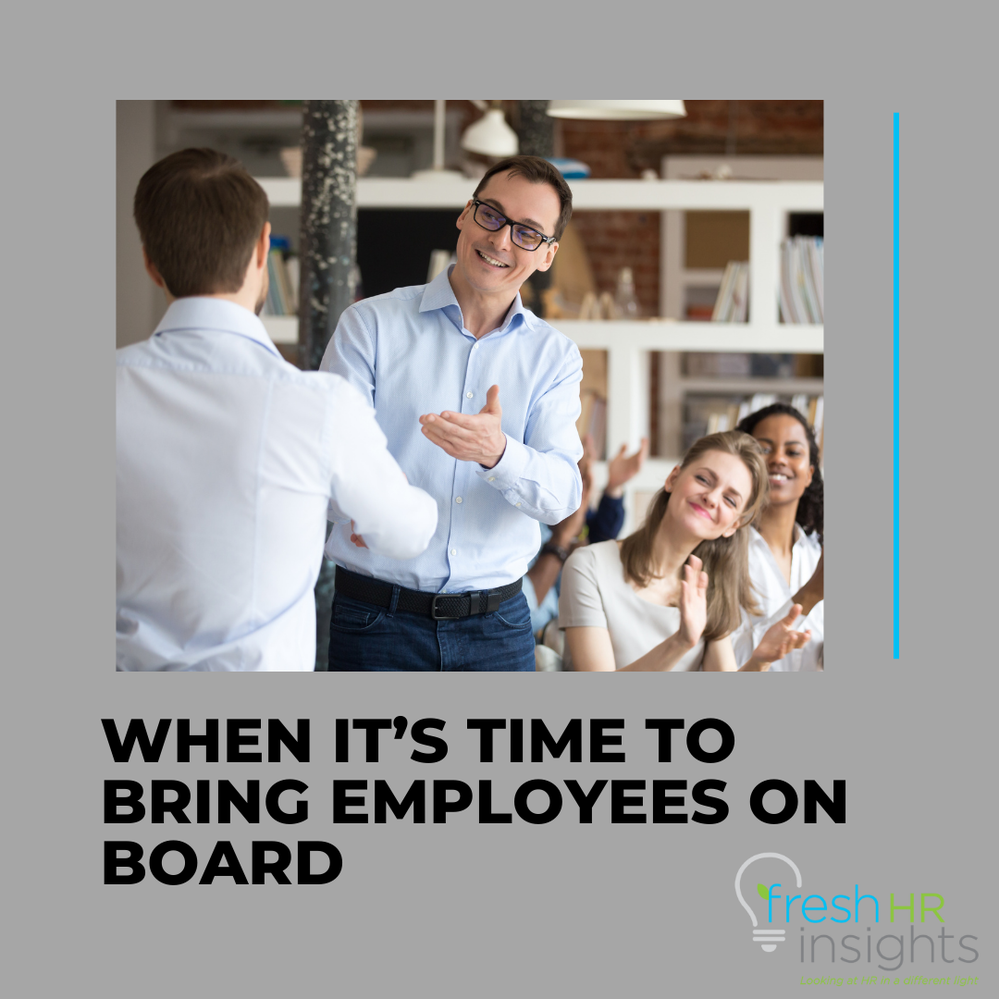

The Right Time to Start Hiring Employees
Onboarding employees can be tricky. But getting it wrong can prove detrimental to your business. Not only can you open yourself up to potential legal ramifications, but you can also cause unsettled cultural issues within the existing team.
The employee onboarding process, as shown above in the meaning of onboarding, involves bringing a new employee into the organisation. You need to consider the totality of employee relations in taking on the new employee’s in their first month on the job. Employee onboarding includes new hire forms, structural familiarizations, and training as well as meeting essential team members, socializing with company employees, and learning how your company’s processes work – the way we do things around here. Its not all paperwork and compliance however – there is the settling into new norms, new ways or doing things, new process and new personalities to navigate.
Truth time – “The lack of effective onboarding is a major reason why companies lose 17% of their new hires within the first three months and why 20% of all staff turnover occurs within 45 days of employment” Jeff Hyman 2018
Here’s the thing to remember – employees cost not only your time, but they also cost money. You have the wages, the superannuation, Work cover insurance and taxation obligations as well as the services of a bookkeeper/ payroll expert (unless running it yourself) – you also have the required equipment (computer, phone, desk, stationary etc.). This can soon mount up so it’s a really good idea – and one that I promote that you get the budget in order.
Before you decided that yep I am ready to start the process of recruitment and selection and taking on an employee you need to make sure that you’re financially prepared. As mentioned above what I suggest for the small business owners out there is to think about how much they’re going to pay the particular employee. This consideration should be straightforward because payment should be directly associated with the position being occupied (you can get the payrates at the Fair Work Ombudsman – https://www.fairwork.gov.au/pay).
Payment as the first consideration it’s obviously to make sure that as a small business owner you can cover the remuneration that is applicable within the award associated with your industry as well as the level within that Award. It’s essential for a business owner to put aside money to cover the employee’s award for at least three months. You can find all the award information at Fair Work Ombudsman – https://www.fairwork.gov.au/awards-and-agreements/awards)
When the lump sum amount is put into a high-interest savings account and then allowed to just sit there to gain interest over time. Let the savings work for you collecting interest until you need it. And when the time comes that you can afford to pay the award amount every single week for three months, then it looks like you’ll be financially able to employ someone. You also have a nice little financial back stop – so leave it alone!
There’s nothing worse than bringing someone on board and finding out that you cannot pay them their wage on a consistent basis.
That’s not a situation that you want to experience as a business owner – it can be sole destroying and if not handled correctly you may end up the legal ramifications (Redundancy v Unfair Dismissal).If you get to the three-month mark of putting the money aside and find that it’s not the right thing for right now because you’ve had to think about it, then no worries you’ve got a little investment money for your troubles.
Remember, once you bring someone on board, depending on what kind of employee you’re bringing on, you want to be covered. If your situation requires an occasional, then you’ve got a bit more flexibility. But if you’re looking for a permanent part-time/permanent full-time, you’ve got a notice period to consider on top of the weekly. I can’t stress this enough – be prepared. You don’t want to back yourself into a corner; that’s for sure.
“Set aside at least three months saving in a high-interest savings account!”
When you bring a person on board as a small business owner, it’s tempting to carry on wanting to manage the entire process and not letting go. Starting to map out the letting process is critical. There’s no point bringing an employee on board and becoming that helicopter. Nobody likes a micromanager. Not to mention, it’s a waste of time and resources.
You want to free up time to work on your business, not create more time working in your business. And that’s why you’re going to bring on an employee.You also need to ensure you have the workload and workflow for them to stay busy. It’s annoying if you’re paying a wage to someone and they are just sitting there doing nothing. And you’d be lying if you said, “No, won’t.” you will. Again, this comes down to what business you’re running and what you need the employee to do.
Within the first three months, you have a three-month grace period to examine the working relationship between your operations and the new employee. Use this time to work out the role and everything. Now, if your business is fluctuating where some weeks are busy, and other weeks it’s quiet, I would recommend you look at getting casual.
A casual employee doesn’t have set hours. Each day is placed into their contract, and then they start again the next time you have them in. One week you might only need them three days out of the week. And the following week you might need them four days. And the next week you might only need them for one day. With a casual, you’ve got that flexibility. Whereas for the permanent part-time person or a permanent full-time, they have consistent, regular hours and you must pay them even if there’s no work for them. So that’s why casual for specific circumstances is a much better option.
Now, there is casual for conversions across all the awards, so you need to be mindful of that.But that doesn’t apply to an irregular or casual. Someone who’s hours are all over the place. You don’t need to worry about it if you’ve got a regular casual, only if you’ve got a systematic or consistent casual when their hours are predictable does it apply; this is something that I can help you navigate.
Here’s a free hiring checklist so you can go and have a look at what the employer/employee relationship can be. The list also shows all the different categories of staff personnel that you can employ. Checklist the expanded directory is available on the business.gov.au website. Use this checklist as a guide when you’re looking to hire people.
- What kind of employment are you offering?
- Is your worker an employee or a contractor?
- Can your employee legally work in Australia?
- What are your employee’s rights under anti-discrimination laws?
- What are your recordkeeping requirements?
- Are you paying the correct wages and entitlements?
- What tax do you need to deduct from your employee’s pay?
All onboarding is essentially induction and assimilation of a new employee into a company or organization. The onboarding process gives new employees an upfront and in-depth understanding of company’s brand, values, and environment. On boarding done correctly helps to clarify the workplace culture, institutional expectations, and performance benchmarks. In short, it is the process by which employees get acquainted and are successfully assimilated into their positions within your company.
From the initial welcome, paperwork, and job requirements, the entire process can become very time consuming and frustrating. If handled poorly, it can decrease attrition and increase turnover rates. But if done systematically, employees can be developed into satisfied team players.
Key hiring and onboarding essential to keep top of mind:
- Compliance: Legal compliance and compliance with organization rules;
- Explanation: Ensuring employees understand their new jobs;
- Logistics: Help new employees show up at the right place to do their jobs.
- Culture: Providing employees with a sense of organizational norms;
- Management: Good management removes silos and provides support in the process of getting their job done right; and
- Training: Consistently provide new employees with learning opportunities that will bring them up to speed quickly.
These are some pillars of a company’s potential onboarding strategy, that if built well can positively affects a company’s growth over the long term.

- Business Name
- Fresh HR Insights
- Business Category
- Business Consultancy
- Official Website
- freshhrinsights.com.au
- Business Number
- 72606799973
- Social Links
- Phone Number
- 0452471960
- Business Location
- 1 Morning Tide Ln
Coomera 4209
Queensland
Australia




